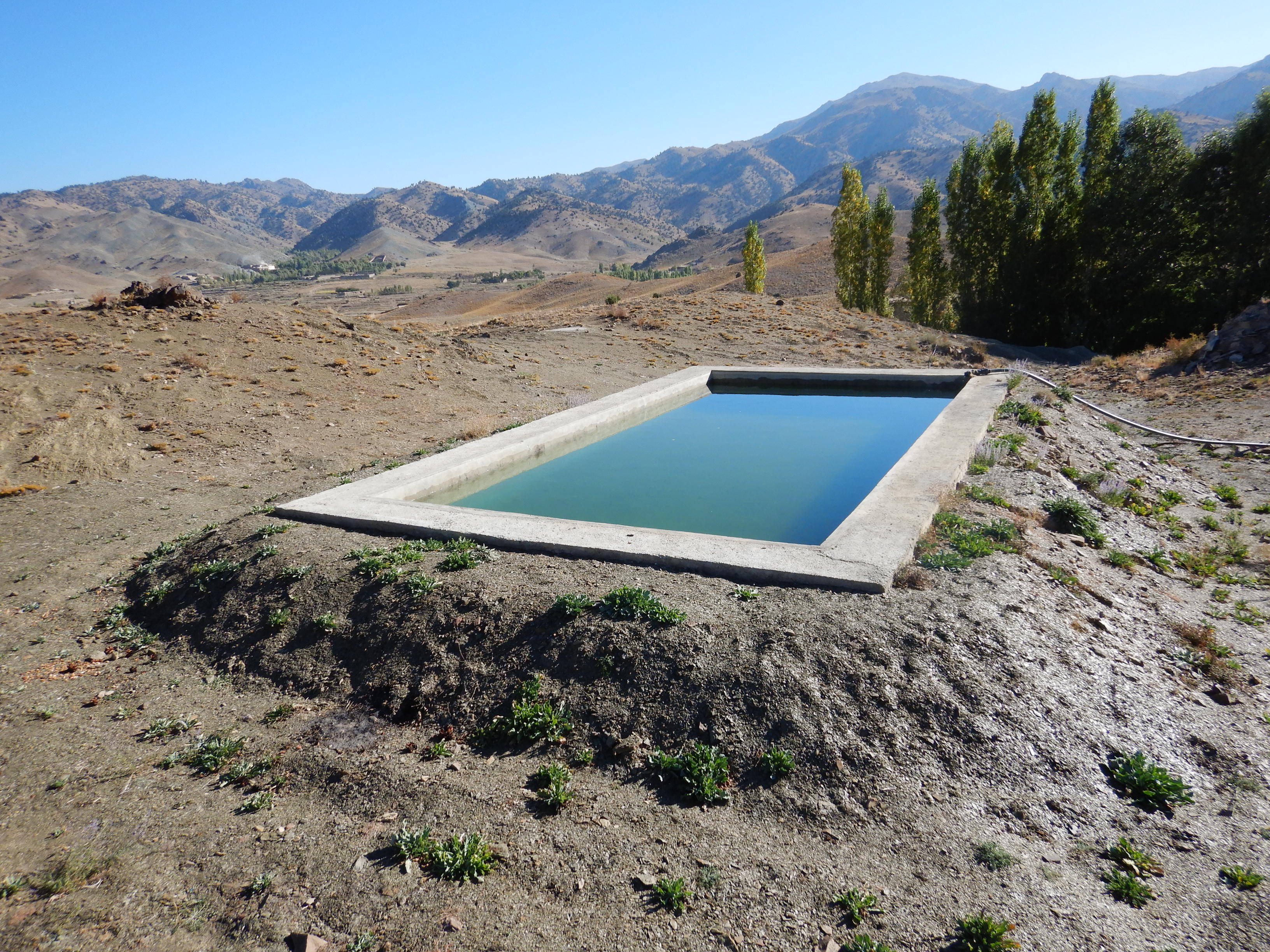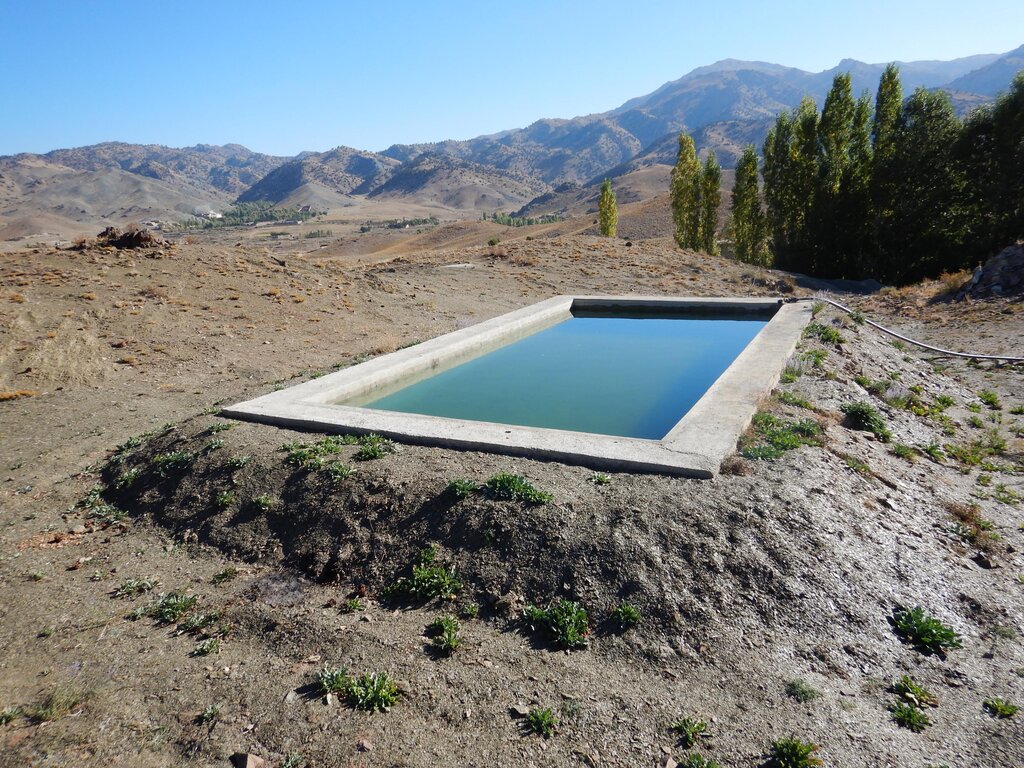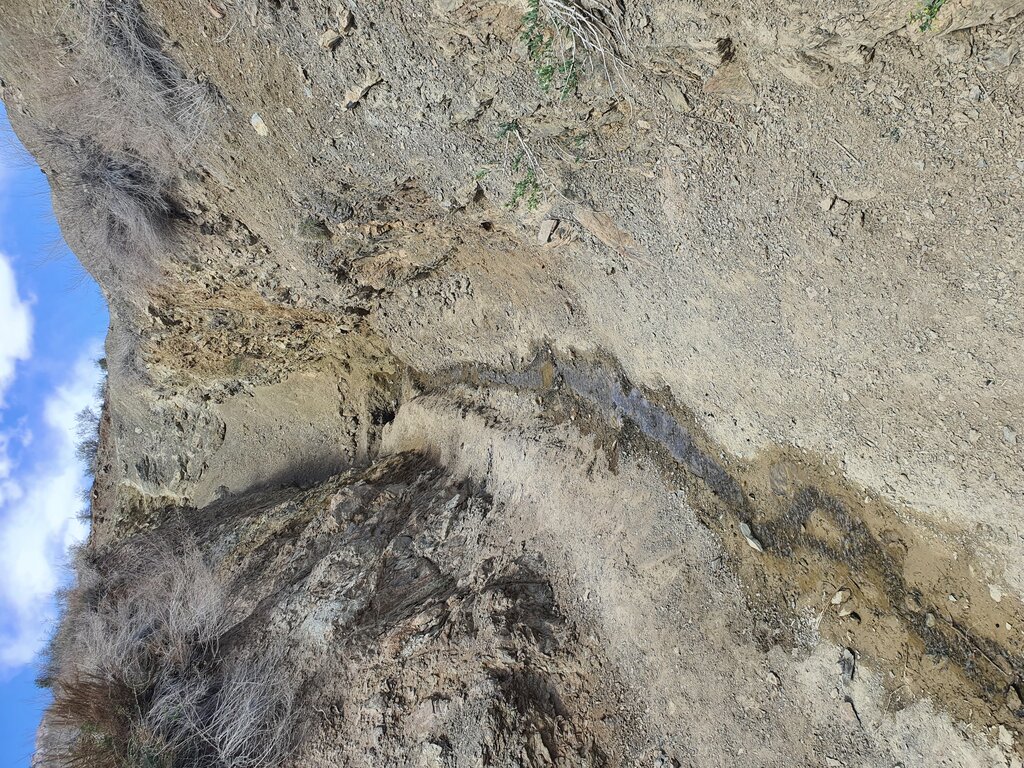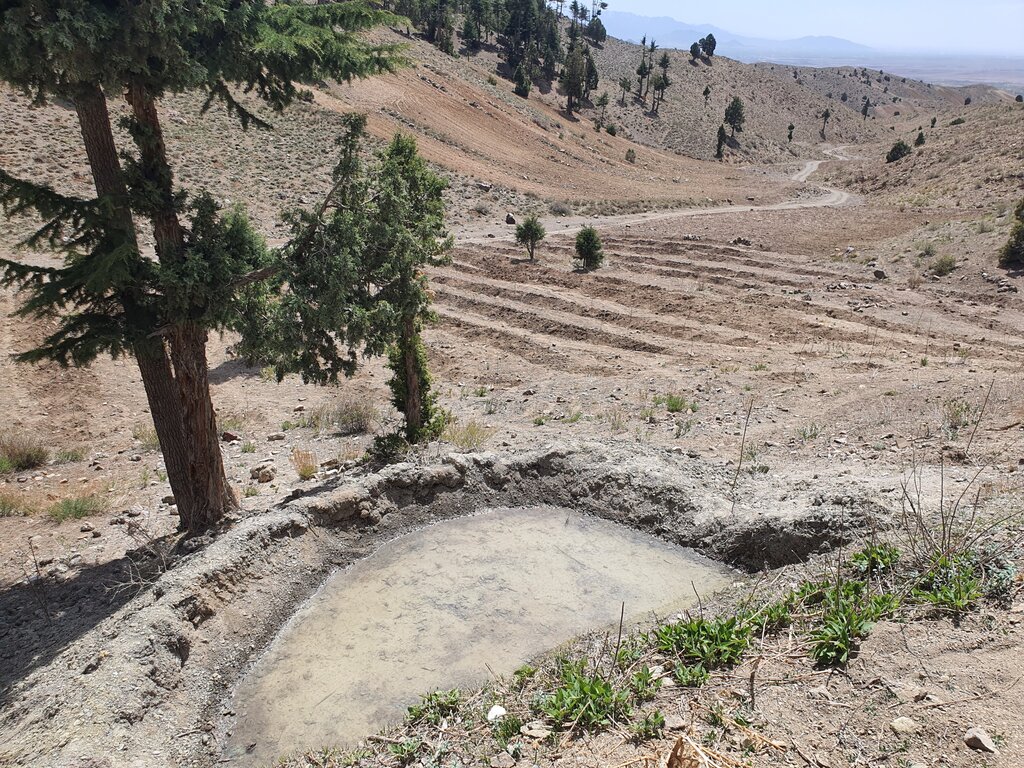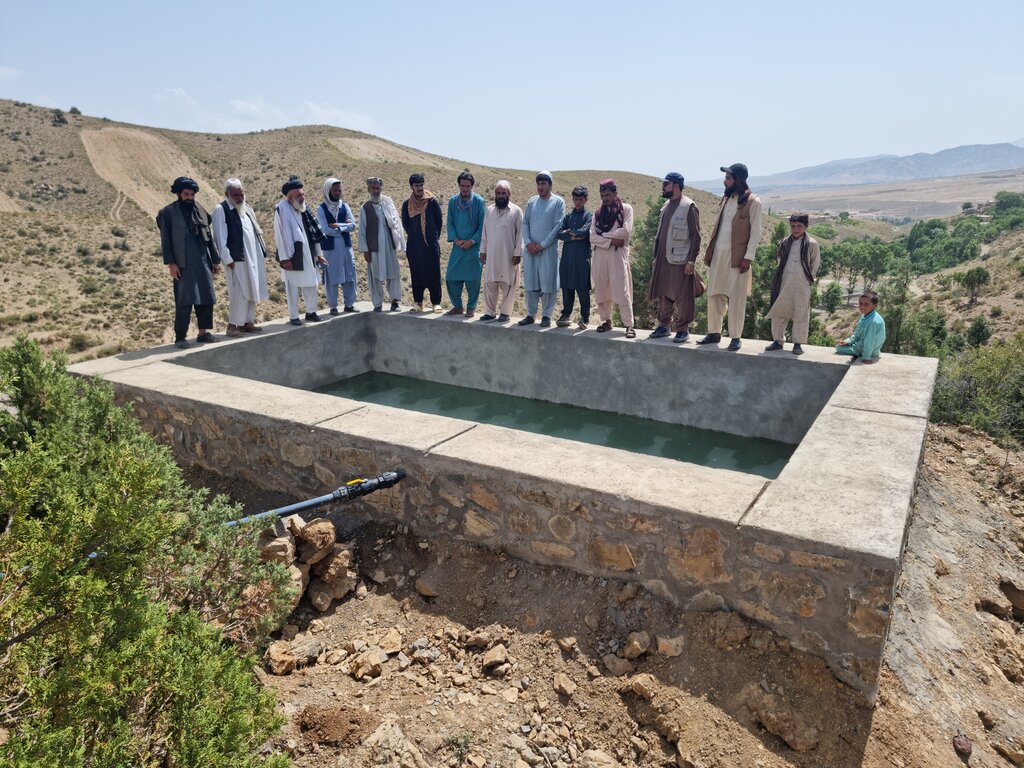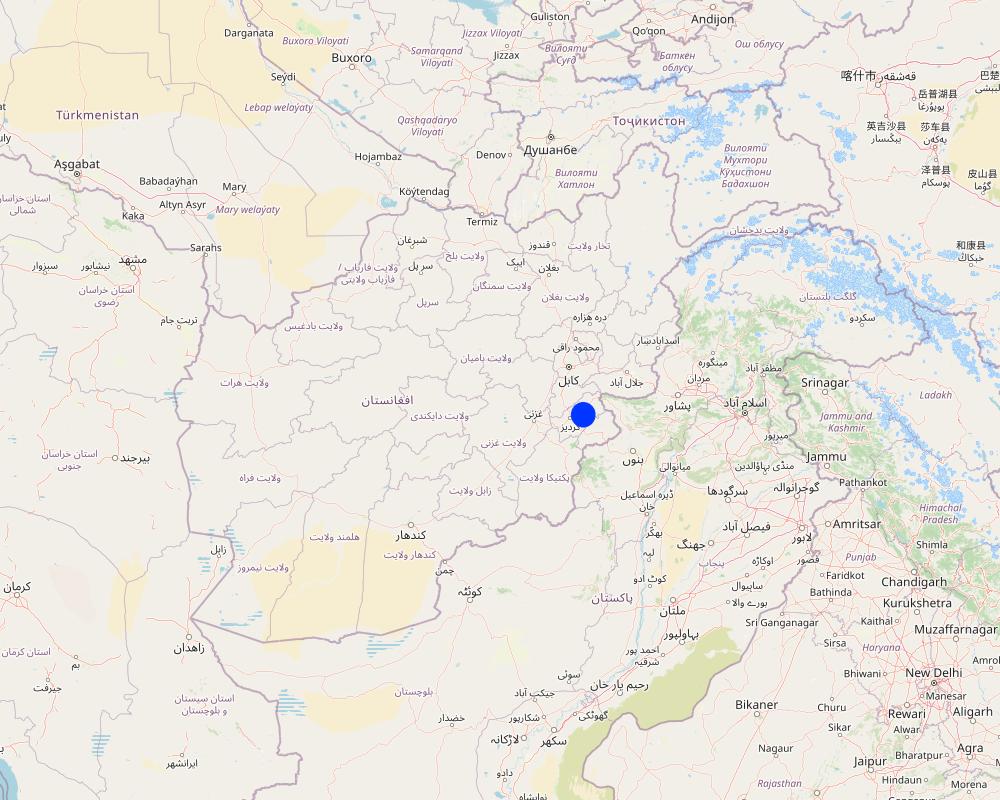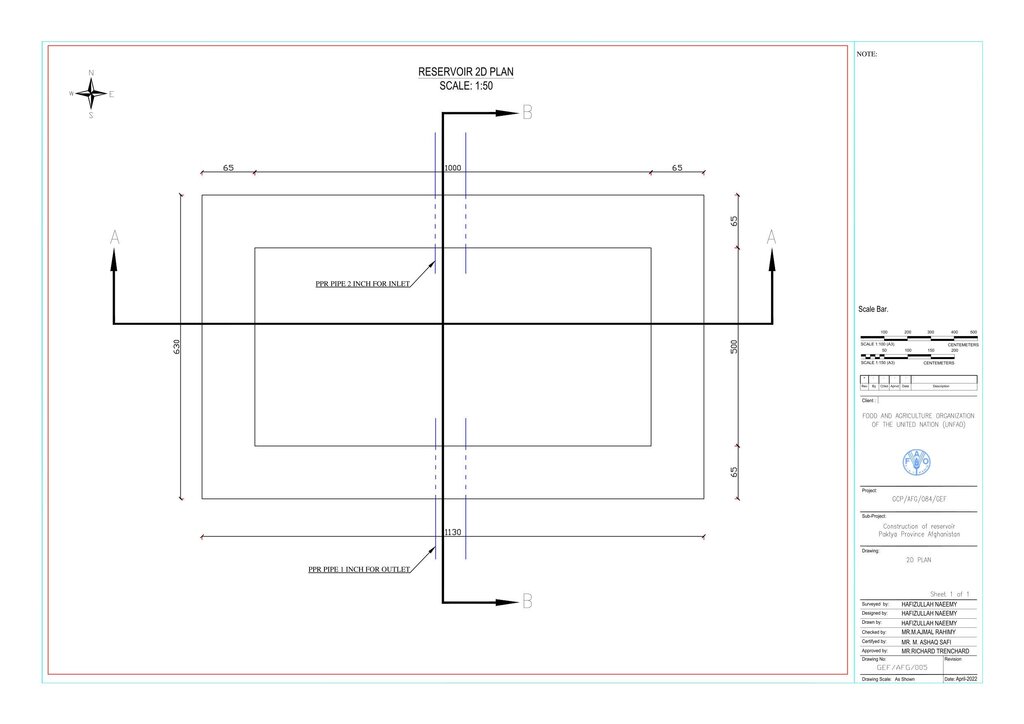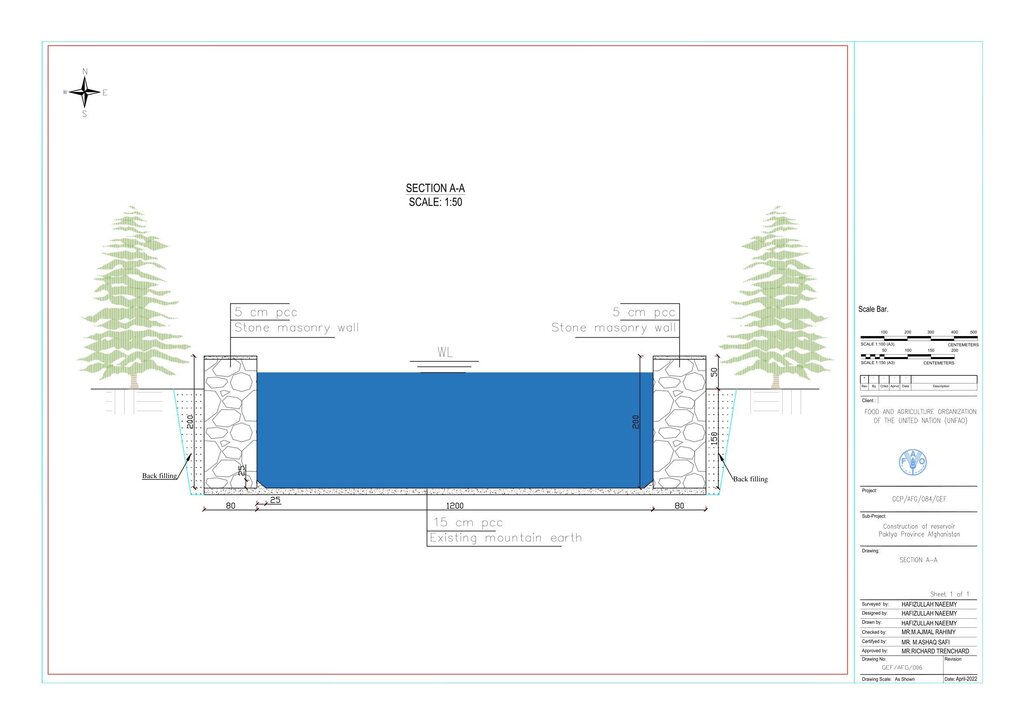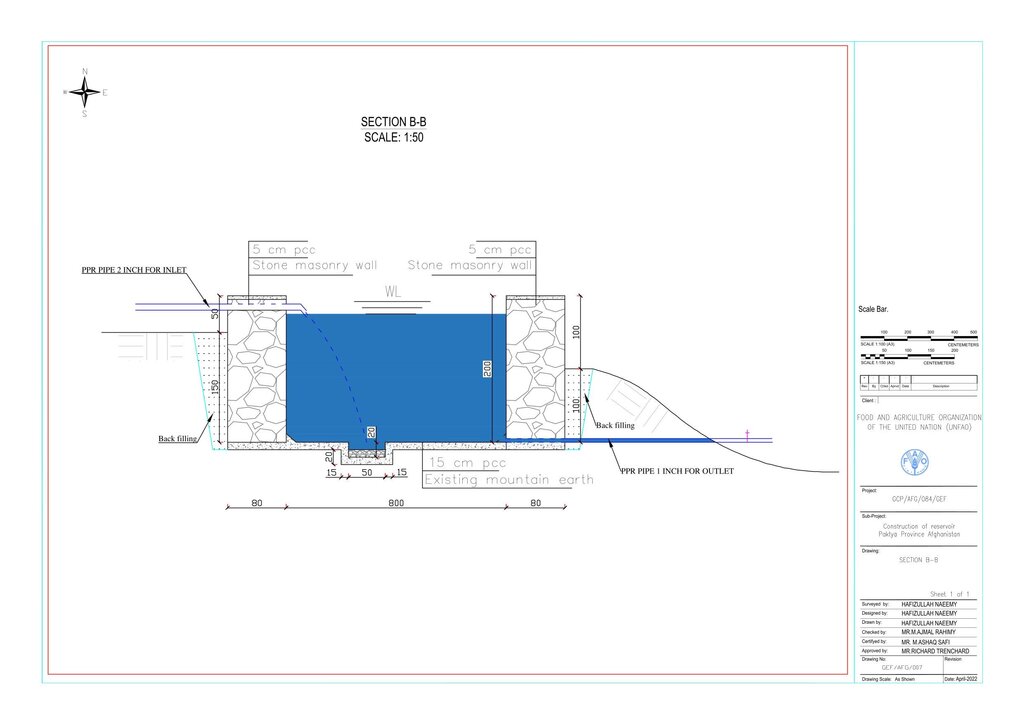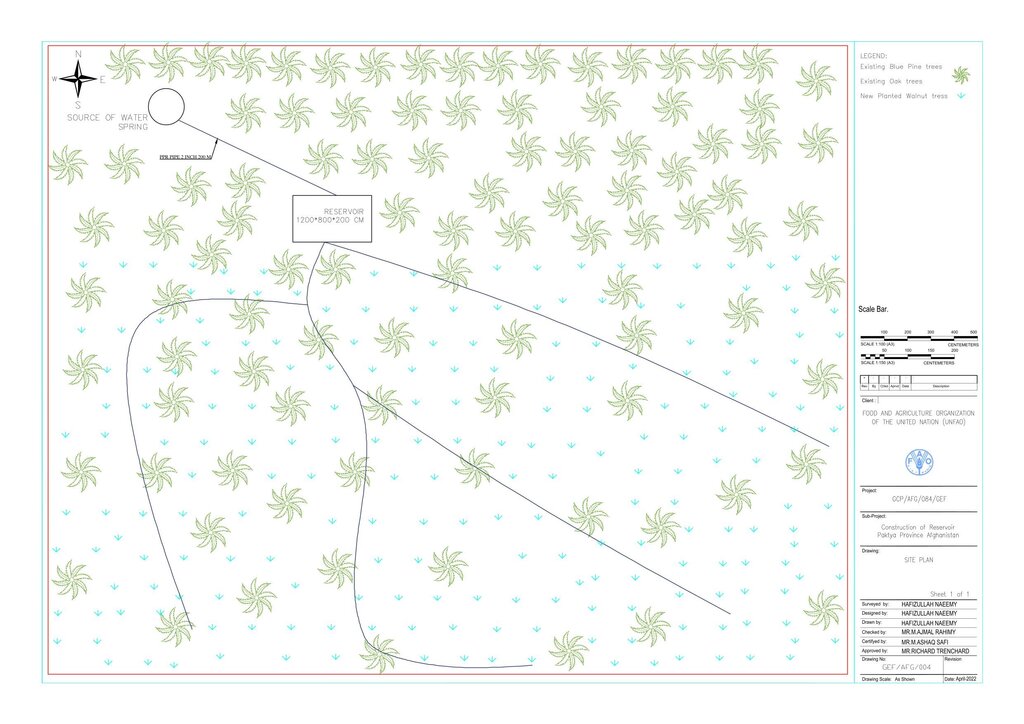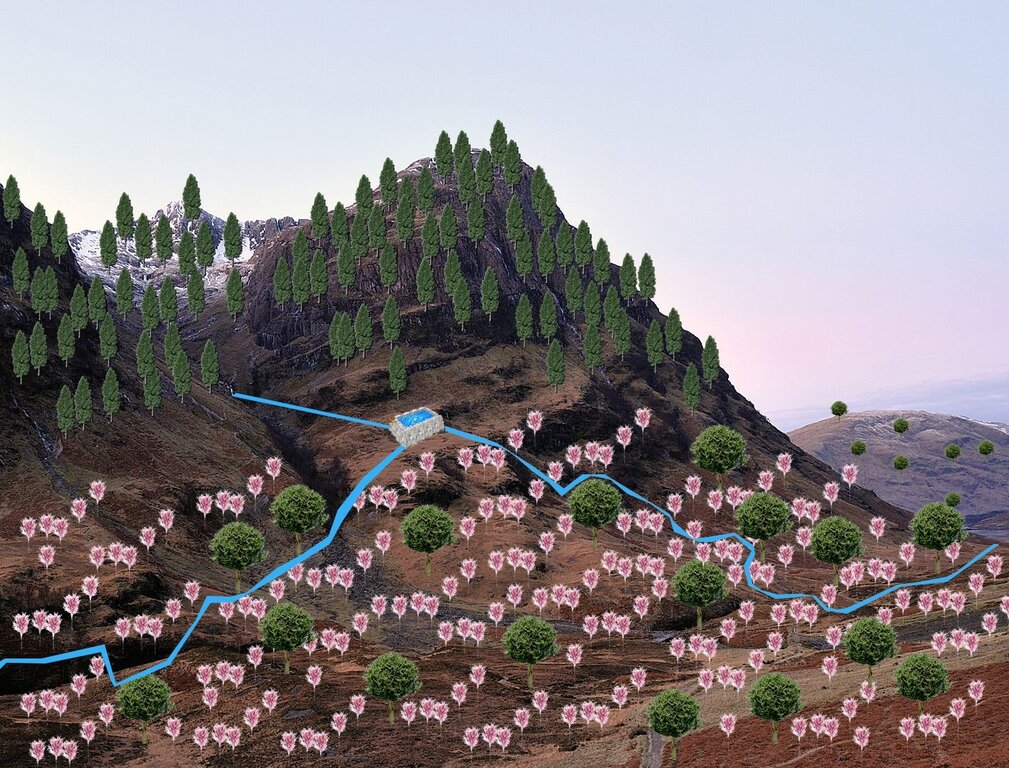Gravity Irrigation for enhancing Community-Based Restoration efforts in the degraded forests of Paktya [อัฟกานิสถาน]
- ผู้สร้างสรรค์:
- การอัพเดท:
- ผู้รวบรวม: Mohammad Wazir Ahmadzai
- ผู้เรียบเรียง: Mir Wali Khan Lakanwal, Mohammad Mustafa Sahebzada, Mohammad Ajmal Rahimy
- ผู้ตรวจสอบ: Rima Mekdaschi Studer, Illias Animon, Muhammad Ishaq Safi, Megha bajaj
Obu Zakhira
technologies_7481 - อัฟกานิสถาน
ดูส่วนย่อย
ขยายทั้งหมด ย่อทั้งหมด1. ข้อมูลทั่วไป
1.2 รายละเอียดที่ติดต่อได้ของผู้รวบรวมและองค์กรที่เกี่ยวข้องในการประเมินและการจัดเตรียมทำเอกสารของเทคโนโลยี
ชื่อของโครงการซึ่งอำนวยความสะดวกในการทำเอกสารหรือการประเมินเทคโนโลยี (ถ้าเกี่ยวข้อง)
Community-based sustainable land and forest management in Afghanistanชื่อขององค์กรซึ่งอำนวยความสะดวกในการทำเอกสารหรือการประเมินเทคโนโลยี (ถ้าเกี่ยวข้อง)
FAO Afghanistan (FAO Afghanistan) - อัฟกานิสถาน1.3 เงื่อนไขการใช้ข้อมูลที่ได้บันทึกผ่านทาง WOCAT
ผู้รวบรวมและวิทยากรหลักยอมรับเงื่อนไขเกี่ยวกับการใช้ข้อมูลที่ถูกบันทึกผ่านทาง WOCAT:
ใช่
1.4 การเปิดเผยเรื่องความยั่งยืนของเทคโนโลยีที่ได้อธิบายไว้
เทคโนโลยีที่ได้อธิบายไว้นี้เป็นปัญหาของความเสื่อมโทรมโทรมของที่ดินหรือไม่ จึงไม่ได้รับการยอมรับว่าเป็นเทคโนโลยีเพื่อการจัดการที่ดินอย่างยั่งยืน:
ไม่ใช่
2. การอธิบายลักษณะของเทคโนโลยี SLM
2.1 การอธิบายแบบสั้น ๆ ของเทคโนโลยี
คำจำกัดความของเทคโนโลยี:
Using a gravity-irrigation system, spring water is diverted to fill reservoirs and then distributed to fields for the restoration of degraded forest areas, with the active involvement of local communities and a focus on the sustainable use of water resources (spring water).
2.2 การอธิบายแบบละเอียดของเทคโนโลยี
คำอธิบาย:
The Paktya province in Afghanistan, known for its mountainous terrain and rich forests of pine nuts deodar, cedar, and conifers, faces severe challenges. Most water in the province comes from rivers, springs, and tube wells, with high mountains acting as natural reservoirs. Unfortunately, many traditional water sources have been destroyed over decades of conflict and natural drought, forcing farmers to rely on costly tube wells for irrigation.
To support sustainable water management in the mountainous areas of Ahmad Aba and Sayed Karam districts, 60 water reservoirs with a total storage capacity of 6,000 m³ were constructed. The volume of individual reservoirs varies depending on the availability and flow of upstream spring water ranging from 36 m³ to 192 m³.
Water is diverted from a small intake near the source and delivered to the reservoir inlet through a 2-inch Polyvinyl Chloride (PVC) pipe. For irrigation of the restored areas, the outlets from the reservoirs are connected to 1-inch PVC pipes for distributing water to various plantation sites.
This technology is applied in a natural environment and is designed to support environmental sustainability by recharging the groundwater table, as water is harvested into reservoirs, it can infiltrate through the side walls and bottom. This percolation process contributes to the natural hydrological cycle, harvesting surplus water (water evaporate or percolating into atmosphere or soil) into reservoirs for irrigation of planted saplings, and extending existing forest boundaries.
The system enables the local community to sustainably manage and utilize spring water for gravity-based irrigation of restored areas, while also supporting the expansion of forested land through sapling plantation.
Before constructing the reservoirs, a feasibility survey of the water source (the spring) was conducted to verify the perennial availability of water and to determine the optimal distance between the spring and the designated reforestation sites. The preliminary selection of reservoir locations was based on key criteria including the year-round reliability of the water source, the size of the target reforestation area, and the discharge capacity of the spring. Excavation of the rocky mountain earth was carried out using a hand excavator as per the specified requirements as per technical drawing and approved design. The stone masonry work was completed using random rubble coursed stone with a cement-sand mortar mix (1:2, Type A). As per the design, Plain Cement Concrete (PCC M20) was applied to the top of the stone masonry and on all floors of the reservoirs. A 20 mm thick plastering was carried out on the internal walls using cement-sand mix (1:2). The external walls were backfilled to a height of 1.5 meters.
The benefits of this gravity-fed irrigation technique include increased reforestation rates, reduced water loss due to evaporation and runoff, achieved by using closed piping systems instead of open channels, and improved water use efficiency. These improvements have led to higher sapling survival rates and better growth. Overall, the socio-economic and environmental conditions of rural populations have been improved. Additionally, the implementation of the gravity irrigation system has reduced the cost of restoring degraded forests.
As a low-cost, environmentally friendly technology, it allows for the efficient harvesting of spring water for irrigation, supports sapling planting for carbon sequestration, and helps mitigate the severe impacts of climate change.
2.3 รูปภาพของเทคโนโลยี
2.5 ประเทศภูมิภาค หรือสถานที่ตั้งที่เทคโนโลยีได้นำไปใช้และได้รับการครอบคลุมโดยการประเมินนี้
ประเทศ:
อัฟกานิสถาน
ภูมิภาค/รัฐ/จังหวัด:
Paktya
ข้อมูลจำเพาะเพิ่มเติมของสถานที่ตั้ง :
Ahamd Aba and Sayed Karam district
ระบุการกระจายตัวของเทคโนโลยี:
- กระจายไปอย่างสม่ำเสมอในพื้นที่
Is/are the technology site(s) located in a permanently protected area?
ใช่
แสดงความคิดเห็น:
The technology being applied in various location of forest areas, while in the map only two points highlighted in Ahmad Aba and Sayed Karam district of Paktya
However, 46 water reservoirs constructed in Sayed Karam, while 14 water reservoirs constructed in Ahmad Ab
Map
×2.6 วันที่การดำเนินการ
ถ้าไม่รู้ปีที่แน่นอน ให้ระบุวันที่โดยประมาณ:
- น้อยกว่า 10 ปี (ไม่นานนี้)
2.7 คำแนะนำของเทคโนโลยี
ให้ระบุว่าเทคโนโลยีถูกแนะนำเข้ามาอย่างไร:
- ทางโครงการหรือจากภายนอก
3. การจัดประเภทของเทคโนโลยี SLM
3.1 วัตถุประสงค์หลักของเทคโนโลยี
- ลด ป้องกัน ฟื้นฟู การเสื่อมโทรมของที่ดิน
- อนุรักษ์ระบบนิเวศน์
- ป้องกันพื้นที่ลุ่มน้ำ/บริเวณท้ายน้ำ โดยร่วมกับเทคโนโลยีอื่นๆ
- รักษาสภาพหรือปรับปรุงความหลากหลายทางชีวภาพ
- ชะลอการเปลี่ยนแปลงภูมิอากาศของโลกและผลกระทบ
- สร้างผลกระทบทางด้านเศรษฐกิจที่เป็นประโยชน์
- สร้างผลกระทบทางด้านสังคมที่เป็นประโยชน์
3.2 ประเภทของการใช้ที่ดินในปัจจุบันที่ได้นำเทคโนโลยีไปใช้
Land use mixed within the same land unit:
ไม่ใช่
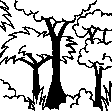
ป่า/พื้นที่ทำไม้
- ป่า/พื้นที่ทำไม้
Tree plantation, afforestation: Specify origin and composition of species:
- การปลูกพืชพันธุ์ท้องถิ่นชนิดเดียว
Type of tree plantation, afforestation:
- subtropical dry forest plantation - Pinus spp.
Type of tree:
- Pinus species
Are the trees specified above deciduous or evergreen?
- mixed deciduous/ evergreen
ผลิตภัณฑ์และบริการ:
- ไม้ซุง
- ไม้ที่นำมาทำเป็นเชื้อเพลิง
- ผลไม้และถั่ว
3.3 Has land use changed due to the implementation of the Technology?
Has land use changed due to the implementation of the Technology?
- No (Continue with question 3.4)
Land use mixed within the same land unit:
ไม่ใช่
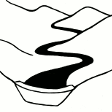
ทางน้ำ แหล่งน้ำ พื้นที่ชุ่มน้ำ
แสดงความคิดเห็น:
With the implementation of the technology, degraded land has been restored to forested areas through reforestation.
3.4 การใช้น้ำ
การใช้น้ำของที่ดินที่มีการใช้เทคโนโลยีอยู่:
- การชลประทานแบบเต็มรูปแบบ
3.5 กลุ่ม SLM ที่ตรงกับเทคโนโลยีนี้
- การจัดการสวนป่า
- การจัดการด้านชลประทาน (รวมถึงการลำเลียงส่งน้ำ การระบายน้ำ)
- การจัดการน้ำผิวดิน (น้ำพุ แม่น้ำทะเลสาบ ทะเล)
3.6 มาตรการ SLM ที่ประกอบกันเป็นเทคโนโลยี
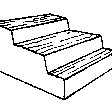
มาตรการอนุรักษ์ด้วยโครงสร้าง
- S5: เขื่อน ชั้นดินที่แน่นแข็งบ่อน้ำ
3.7 รูปแบบหลักของการเสื่อมโทรมของที่ดินที่ได้รับการแก้ไขโดยเทคโนโลยี
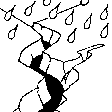
การกัดกร่อนของดินโดยน้ำ
- Wt (Loss of topsoil): การสูญเสียดินชั้นบนหรือการกัดกร่อนที่ผิวดิน
- Wg (Gully erosion): การกัดกร่อนแบบร่องธารหรือการทำให้เกิดร่องน้ำเซาะ
3.8 การป้องกัน การลดลง หรือการฟื้นฟูความเสื่อมโทรมของที่ดิน
ระบุเป้าหมายของเทคโนโลยีกับความเสื่อมโทรมของที่ดิน:
- ลดความเสื่อมโทรมของดิน
4. ข้อมูลจำเพาะด้านเทคนิค กิจกรรมการนำไปปฏิบัติใช้ ปัจจัยนำเข้า และค่าใช้จ่าย
4.1 แบบแปลนทางเทคนิคของเทคโนโลยี
ข้อมูลจำเพาะด้านเทคนิค (แบบแปลนทางเทคนิคของเทคโนโลยี):
Technical drawing: indicated the details of the dimension of water reservoirs
ผู้เขียน:
Hafizullah Neemy
วันที่:
30/03/2022
ข้อมูลจำเพาะด้านเทคนิค (แบบแปลนทางเทคนิคของเทคโนโลยี):
Technical drawing
ผู้เขียน:
Hafizullah Neemy
วันที่:
23/03/2022
ข้อมูลจำเพาะด้านเทคนิค (แบบแปลนทางเทคนิคของเทคโนโลยี):
Technical drawing
ผู้เขียน:
Hafizullah Neemy
วันที่:
30/03/2022
ข้อมูลจำเพาะด้านเทคนิค (แบบแปลนทางเทคนิคของเทคโนโลยี):
Drawing
ผู้เขียน:
Hafizullah Neemy
วันที่:
30/03/2022
4.2 ข้อมูลทั่วไปเกี่ยวกับการคำนวณปัจจัยนำเข้าและค่าใช้จ่าย
ให้ระบุว่าค่าใช้จ่ายและปัจจัยนำเข้าได้รับการคำนวณอย่างไร:
- ต่อพื้นที่ที่ใช้เทคโนโลยี
ระบุสกุลเงินที่ใช้คำนวณค่าใช้จ่าย:
- USD
ระบุค่าเฉลี่ยของค่าจ้างในการจ้างแรงงานต่อวัน:
5
4.3 กิจกรรมเพื่อการจัดตั้ง
| กิจกรรม | Timing (season) | |
|---|---|---|
| 1. | Excavation to build reservoirs | When construction work is possible |
| 2. | Back filling of all outside of reservoir through soil | After construction the reservoir |
| 3. | Stone masonry using random rubble coursed stone, laid with a cement-sand mortar mix of 1:2 (Type A) | When construction work is possible |
| 4. | Plain Cement Concrete (PCC) M20 with formwork and waterproof compound applied under and on top of the stone masonry, as well as on the reservoir floor | When construction work is possible |
| 5. | Plastering of internal reservoir wall with cement sand (mix 1:2), 20 mm thick | When construction work is possible |
| 6. | Installation of pipes; 1 and 2 inch with elbow, joints , and connectors and valves for fitting in outlet and inlet area of reservoir | After construction work |
4.4 ค่าใช้จ่ายของปัจจัยนำเข้าที่จำเป็นสำหรับการจัดตั้ง
| ปัจจัยนำเข้า | หน่วย | ปริมาณ | ค่าใช้จ่ายต่อหน่วย | ค่าใช้จ่ายทั้งหมดต่อปัจจัยนำเข้า | %ของค่าใช้จ่ายที่ก่อให้เกิดขึ้นโดยผู้ใช้ที่ดิน | |
|---|---|---|---|---|---|---|
| แรงงาน | Excavation to build the reservoris | M3 | 62.0 | 10.0 | 620.0 | |
| แรงงาน | Stone masonry using random rubble coursed stone, laid with a cement-sand mortar mix of 1:2 (Type A) | M3 | 23.0 | 14.0 | 322.0 | |
| แรงงาน | Plain Cement Concrete (PCC) M20 with formwork and waterproof compound applied under and on top of the stone masonry, as well as on the reservoir floor | M3 | 6.0 | 14.0 | 84.0 | |
| แรงงาน | Plastering of internal reservoir wall with cement sand (mix 1:2), 20 mm thick | M3 | 42.0 | 14.0 | 588.0 | |
| แรงงาน | Back filling of all outside of reservoir through soil | Man-days | 5.0 | 5.0 | 25.0 | |
| แรงงาน | Installation of pipes; 1 and 2 inch with elbow, joints , and connectors and valves for fitting in outlet and inlet area of reservoir | Man-days | 8.0 | 5.0 | 40.0 | |
| อุปกรณ์ | Shovel | PC | 5.0 | 5.0 | 25.0 | |
| อุปกรณ์ | Hammer | PC | 2.0 | 10.0 | 20.0 | |
| อุปกรณ์ | Excavator (taking by rent for excavation) | Cubic meter cost | 192.0 | 10.0 | 1920.0 | |
| วัสดุสำหรับก่อสร้าง | Cement | Package | 75.0 | 6.0 | 450.0 | |
| วัสดุสำหรับก่อสร้าง | Stone | Cubic meters | 23.0 | 14.0 | 322.0 | |
| วัสดุสำหรับก่อสร้าง | Polyethelen pipe 1 inch | Meter | 500.0 | 0.8 | 400.0 | |
| วัสดุสำหรับก่อสร้าง | Polyethelen pipe 2 inch | Meter | 200.0 | 1.0 | 200.0 | |
| วัสดุสำหรับก่อสร้าง | Elbow joint | Piece | 3.0 | 1.0 | 3.0 | |
| วัสดุสำหรับก่อสร้าง | Valves | Piece | 4.0 | 4.0 | 16.0 | |
| วัสดุสำหรับก่อสร้าง | Sand | Cumbic meter | 20.0 | 5.0 | 100.0 | |
| อื่น ๆ | Transportation | LS | 1.0 | 700.0 | 700.0 | |
| ค่าใช้จ่ายทั้งหมดของการจัดตั้งเทคโนโลยี | 5835.0 | |||||
| Total costs for establishment of the Technology in USD | 5835.0 | |||||
4.5 การบำรุงรักษาสภาพหรือกิจกรรมที่เกิดขึ้นเป็นประจำ
| กิจกรรม | ช่วงระยะเวลา/ความถี่ | |
|---|---|---|
| 1. | Installation of pipes to outlet and inlet area of water reservoir | Spring season |
| 2. | Maintenance of reservoir for clearing and unclogging the inlet area | As per requirement |
| 3. | Replacement and installation of valves and elbow joints to prevent water clogging in the pipes | During non-function |
| 4. | The embankment constructed to accumulate the water and put the pipes inside to water for diverting to the reservoir | Spring season |
4.6 ค่าใช้จ่ายของปัจจัยนำเข้าและกิจกรรมที่เกิดขึ้นเป็นประจำที่ต้องการการบำรุงรักษา (ต่อปี)
| ปัจจัยนำเข้า | หน่วย | ปริมาณ | ค่าใช้จ่ายต่อหน่วย | ค่าใช้จ่ายทั้งหมดต่อปัจจัยนำเข้า | %ของค่าใช้จ่ายที่ก่อให้เกิดขึ้นโดยผู้ใช้ที่ดิน | |
|---|---|---|---|---|---|---|
| แรงงาน | Labour for repairing of pipes at outlet and valves | Person | 1.0 | 100.0 | 100.0 | 100.0 |
| แรงงาน | Labour for clearing and unclogging | Person | 1.0 | 50.0 | 50.0 | 100.0 |
| วัสดุสำหรับก่อสร้าง | Valves | PC | 5.0 | 3.0 | 15.0 | 100.0 |
| วัสดุสำหรับก่อสร้าง | Elbow joint | Pc | 5.0 | 1.0 | 5.0 | 100.0 |
| ค่าใช้จ่ายทั้งหมดของการบำรุงรักษาสภาพเทคโนโลยี | 170.0 | |||||
| Total costs for maintenance of the Technology in USD | 170.0 | |||||
4.7 ปัจจัยสำคัญที่สุดที่มีผลกระทบต่อค่าใช้จ่าย
ปัจจัยสำคัญที่สุดที่มีผลกระทบต่อค่าใช้จ่ายต่างๆ:
The distance between the spring and reservoir can affect the total cost of technology
5. สิ่งแวดล้อมทางธรรมชาติและของมนุษย์
5.1 ภูมิอากาศ
ฝนประจำปี
- < 250 ม.ม.
- 251-500 ม.ม.
- 501-750 ม.ม.
- 751-1,000 ม.ม.
- 1,001-1,500 ม.ม.
- 1,501-2,000 ม.ม.
- 2,001-3,000 ม.ม.
- 3,001-4,000 ม.ม.
- > 4,000 ม.ม.
ระบุปริมาณน้ำฝนเฉลี่ยรายปี (ถ้ารู้) :หน่วย ม.ม.
553.00
เขตภูมิอากาศเกษตร
- กึ่งแห้งแล้ง
5.2 สภาพภูมิประเทศ
ค่าเฉลี่ยความลาดชัน:
- ราบเรียบ (0-2%)
- ลาดที่ไม่ชัน (3-5%)
- ปานกลาง (6-10%)
- เป็นลูกคลื่น (11-15%)
- เป็นเนิน (16-30%)
- ชัน (31-60%)
- ชันมาก (>60%)
ธรณีสัณฐาน:
- ที่ราบสูง/ที่ราบ
- สันเขา
- ไหล่เขา
- ไหล่เนินเขา
- ตีนเนิน
- หุบเขา
ระดับความสูง:
- 0-100 เมตร
- 101-500 เมตร
- 501-1,000 เมตร
- 1,001-1,500 เมตร
- 1,501-2,000 เมตร
- 2,001-2,500 เมตร
- 2,501-3,000 เมตร
- 3,001-4,000 เมตร
- > 4,000 เมตร
ให้ระบุถ้าเทคโนโลยีได้ถูกนำไปใช้:
- บริเวณสันเขา (convex situations)
ความคิดเห็นและข้อมูลจำเพาะเพิ่มเติมเรื่องสภาพภูมิประเทศ:
The construction site is situated at an elevation of 2500-3000 meters above sea level, with a terrain slope ranging from 15% to 20%. Photo related to field skitch, indicated that the area of reforestation is around the reservoir.
5.3 ดิน
ค่าเฉลี่ยความลึกของดิน:
- ตื้นมาก (0-20 ซ.ม.)
- ตื้น (21-50 ซ.ม.)
- ลึกปานกลาง (51-80 ซ.ม.)
- ลึก (81-120 ซ.ม.)
- ลึกมาก (>120 ซ.ม.)
เนื้อดิน (ดินชั้นบน):
- หยาบ/เบา (ดินทราย)
- ปานกลาง (ดินร่วน ทรายแป้ง)
เนื้อดินล่าง (> 20 ซ.ม.ต่ำจากผิวดิน):
- ปานกลาง (ดินร่วน ทรายแป้ง)
อินทรียวัตถุในดิน:
- ปานกลาง (1-3%)
5.4 ความเป็นประโยชน์และคุณภาพของน้ำ
ระดับน้ำใต้ดิน:
<5 เมตร
น้ำไหลบ่าที่ผิวดิน:
เกินพอ
คุณภาพน้ำ (ที่ยังไม่ได้บำบัด):
เป็นน้ำเพื่อการดื่มที่ดี
Water quality refers to:
both ground and surface water
ความคิดเห็นและข้อมูลจำเพาะเพิ่มเติมเรื่องคุณภาพและปริมาณน้ำ:
As the water from spring harvesting through pipes and accumulated in reservoirs can reduced the evaporation and stored for 2 or 3 days in reservoirs that can excess the water quantity for irrigation purposes.
5.5 ความหลากหลายทางชีวภาพ
ความหลากหลายทางชนิดพันธุ์:
- ปานกลาง
ความหลากหลายของแหล่งที่อยู่:
- ต่ำ
5.6 ลักษณะของผู้ใช้ที่ดินที่นำเทคโนโลยีไปปฏิบัติใช้
อยู่กับที่หรือเร่ร่อน:
- อยู่กับที่
รายได้ที่มาจากนอกฟาร์ม:
- 10-50% ของรายได้ทั้งหมด
ระดับของความมั่งคั่งโดยเปรียบเทียบ:
- จน
- พอมีพอกิน
เป็นรายบุคคล/ครัวเรือน:
- เป็นรายบุคคล/ครัวเรือน
ระดับของการใช้เครื่องจักรกล:
- งานที่ใช้แรงกาย
- การใช้กำลังจากสัตว์
เพศ:
- หญิง
- ชาย
อายุของผู้ใช้ที่ดิน:
- ผู้เยาว์
- วัยกลางคน
- ผู้สูงอายุ
ระบุลักษณะอื่นๆที่เกี่ยวข้องของผู้ใช้ที่ดิน:
All age group excluding children
5.7 Average area of land used by land users applying the Technology
- < 0.5 เฮกตาร์
- 0.5-1 เฮกตาร์
- 1-2 เฮกตาร์
- 2-5 เฮกตาร์
- 5-15 เฮกตาร์
- 15-50 เฮกตาร์
- 50-100 เฮกตาร์
- 100-500 เฮกตาร์
- 500-1,000 เฮกตาร์
- 1,000-10,000 เฮกตาร์
- >10,000 เฮกตาร์
พิจารณาว่าเป็นขนาดเล็ก กลาง หรือขนาดใหญ่ (ซึ่งอ้างอิงถึงบริบทระดับท้องถิ่น):
- ขนาดเล็ก
- ขนาดกลาง
แสดงความคิดเห็น:
The small-scale covered the reforestation areas about 10 ha for irrigation, while the medium scale covered about 20 ha for irrigation purposes.
5.8 กรรมสิทธิ์ในที่ดิน สิทธิในการใช้ที่ดินและสิทธิในการใช้น้ำ
กรรมสิทธิ์ในที่ดิน:
- เป็นแบบชุมชนหรือหมู่บ้าน
สิทธิในการใช้ที่ดิน:
- เกี่ยวกับชุมชน (ถูกจัดระเบียบ)
สิทธิในการใช้น้ำ:
- เกี่ยวกับชุมชน (ถูกจัดระเบียบ)
แสดงความคิดเห็น:
The water reservoirs were constructed on communal land for use by the local community, allowing shared access for irrigating reforested areas. Access and use are managed through a community-agreed contribution system.
5.9 การเข้าถึงบริการและโครงสร้างพื้นฐาน
สุขภาพ:
- จน
- ปานกลาง
- ดี
การศึกษา:
- จน
- ปานกลาง
- ดี
ความช่วยเหลือทางด้านเทคนิค:
- จน
- ปานกลาง
- ดี
การจ้างงาน (เช่น ภายนอกฟาร์ม):
- จน
- ปานกลาง
- ดี
ตลาด:
- จน
- ปานกลาง
- ดี
พลังงาน:
- จน
- ปานกลาง
- ดี
ถนนและการขนส่ง:
- จน
- ปานกลาง
- ดี
น้ำดื่มและการสุขาภิบาล:
- จน
- ปานกลาง
- ดี
บริการด้านการเงิน:
- จน
- ปานกลาง
- ดี
6. ผลกระทบและสรุปคำบอกกล่าว
6.1 ผลกระทบในพื้นที่ดำเนินการ (On-site) จากการใช้เทคโนโลยี
ผลกระทบทางด้านเศรษฐกิจและสังคม
การผลิต
การผลิตไม้
แสดงความคิดเห็น/ระบุ:
The establishment of woodlots and other forest can increase the fuel wood for heating the house and cooking, fodder for livestock and fruit for home consumption. The established woodlots consist of a mix of fruit and non-fruit tree species.
การผลิตของจากป่าทุกชนิดยกเว้นไม้
แสดงความคิดเห็น/ระบุ:
The non-wood forest productions increased with increasing the area of production through gravity irrigation systems enhanced the community-based efforts in degraded forest.
พื้นที่สำหรับการผลิต
แสดงความคิดเห็น/ระบุ:
The production areas of NTFPs have expanded due to the annual planting of saplings in degraded forest areas, supported by water reservoirs that provide irrigation and enable the extension of existing forest boundaries.
ความเป็นประโยชน์และคุณภาพของน้ำ
การมีน้ำไว้ให้สำหรับการชลประทาน
แสดงความคิดเห็น/ระบุ:
The irrigation water availability has improved due to efficient management of the spring water. As the spring water gradually decreases from June to December months which considered as dry period, while January to March months is the wettest period that water is excessive and can be harvested for the following dry period.
ความต้องการน้ำจากการชลประทาน
แสดงความคิดเห็น/ระบุ:
As the construction of water reservoirs can significantly improve the water availability during the year both in the wettest period and followed by dry period, by storing the water can balance the demand for the irrigation water.
รายได้และค่าใช้จ่าย
ความหลากหลายของแหล่งผลิตรายได้
แสดงความคิดเห็น/ระบุ:
Households living in rural areas rely on income from non-timber forest products (NTFPs) and agricultural production, resulting in a diversification of their income sources.
ภาระงาน
แสดงความคิดเห็น/ระบุ:
the workload for the irrigation of reforestation areas reduced with application of technology because the number of days for irrigation done manually reduced and also the cost of irrigation.
ผลกระทบด้านสังคมวัฒนธรรมอื่น ๆ
ความมั่นคงด้านอาหาร / พึ่งตนเองได้
Vegetation Cover
แสดงความคิดเห็น/ระบุ:
Vegetation cover has improved each year due to ongoing tree planting and the protection of designated areas through quarantine measures.
ผลกระทบด้านนิเวศวิทยา
วัฐจักรน้ำหรือน้ำบ่า
ปริมาณน้ำ
การเก็บเกี่ยวหรือการกักเก็บน้ำ
ดิน
ความชื้นในดิน
สิ่งปกคลุมดิน
การสะสมของดิน
การเกิดแผ่นแข็งที่ผิวดิน /การเกิดชั้นดาน
การอัดแน่นของดิน
การหมุนเวียนและการเติมของธาตุอาหาร
อินทรียวัตถุในดิน/ต่ำกว่าดินชั้น C
ความหลากหลายทางชีวภาพของพืชและสัตว์
การปกคลุมด้วยพืช
ลดความเสี่ยงของภัยพิบัติ
ผลกระทบจากน้ำท่วม
ผลกระทบจากภัยแล้ง
การปล่อยคาร์บอนและก๊าซเรือนกระจก
ภูมิอากาศจุลภาค
6.2 ผลกระทบนอกพื้นที่ดำเนินการ (Off-site) จากการใช้เทคโนโลยี
น้ำที่ใช้ประโยชน์ได้
6.3 การเผชิญและความตอบสนองของเทคโนโลยีต่อการเปลี่ยนแปลงสภาพภูมิอากาศที่ค่อยเป็นค่อยไป และสภาพรุนแรงของภูมิอากาศ / ภัยพิบัติ (ที่รับรู้ได้โดยผู้ใช้ที่ดิน)
การเปลี่ยนแปลงสภาพภูมิอากาศที่ค่อยเป็นค่อยไป
การเปลี่ยนแปลงสภาพภูมิอากาศที่ค่อยเป็นค่อยไป
| ฤดู | increase or decrease | เทคโนโลยีมีวิธีการรับมืออย่างไร | |
|---|---|---|---|
| อุณหภูมิตามฤดูกาล | ฤดูร้อน | ลดลง | ดีมาก |
| ฝนประจำปี | เพิ่มขึ้น | ปานกลาง | |
| ฝนตามฤดู | ฤดูใบไม้ผลิ | เพิ่มขึ้น | ดีมาก |
แสดงความคิดเห็น:
The forest function for the regulating of climate, rainfall and snowfall. By increasing the forest cover that can help in regulating the annual rainfall.
6.4 การวิเคราะห์ค่าใช้จ่ายและผลประโยชน์ที่ได้รับ
ผลประโยชน์ที่ได้รับเปรียบเทียบกับค่าใช้จ่ายในการจัดตั้งเป็นอย่างไร (จากมุมมองของผู้ใช้ที่ดิน)
ผลตอบแทนระยะสั้น:
ด้านบวก
ผลตอบแทนระยะยาว:
ด้านบวกเล็กน้อย
ผลประโยชน์ที่ได้รับเปรียบเทียบกับค่าใช้จ่ายในการบำรุงรักษาหรือต้นทุนที่เกิดขึ้นซ้ำอีก เป็นอย่างไร (จากมุมมองของผู้ใช้ที่ดิน)
ผลตอบแทนระยะสั้น:
ด้านบวกเล็กน้อย
ผลตอบแทนระยะยาว:
ด้านบวก
6.5 การปรับตัวของเทคโนโลยี
- 1-10%
Of all those who have adopted the Technology, how many did so spontaneously, i.e. without receiving any material incentives/ payments?
- 0-10%
6.6 การปรับตัว
เทคโนโลยีได้รับการปรับเปลี่ยนเมื่อเร็วๆนี้ เพื่อให้ปรับตัวเข้ากับสภาพที่กำลังเปลี่ยนแปลงหรือไม่:
ใช่
ถ้าตอบว่าใช่ ให้ระบุว่าเงื่อนไขการเปลี่ยนแปลงใดที่ถูกปรับตัว:
- การเปลี่ยนแปลงแบบค่อยเป็นค่อยไปและสภาพรุนแรงของภูมิอากาศ
ให้ระบุการปรับตัวของเทคโนโลยี (การออกแบบ วัสดุหรือชนิดพันธุ์ เป็นต้น):
The technology adapted well to reduce the severe impacts of the water on the plant growth and development during water scarity situation in summer.
6.7 จุดแข็ง / ข้อได้เปรียบ / โอกาสของเทคโนโลยี
| จุดแข็ง / ข้อได้เปรียบ / โอกาสในทัศนคติของผู้ใช้ที่ดิน |
|---|
| The technology is cost-effective for irrigating afforested areas and is easy to use and conducive to implementation. |
| The workload for irrigating the afforested area has been reduced, resulting in fewer man-days required for irrigation. |
| The harvesting of water from ground spring allows to expand the forest area through plantation of saplings, otherwise it not possible. |
| จุดแข็ง / ข้อได้เปรียบ / โอกาสในทัศนคติของผู้รวบรวมหรือวิทยากรหลัก |
|---|
| The sustainable management of ground water spring contributed to the expansion of restoration efforts in the community level. |
| By implementation of technology at specific point, the soil vegetation cover improved from 10 to 15 percent. |
| The biodiversity enhanced with restoration of degraded forest area, through plantation of native species, regeneration of native bushes, grasses. |
| The unproductive soil converted into productive soil through plantation of bio energy plants to produce fuel wood, fodder and fruit. |
6.8 จุดอ่อน / ข้อเสียเปรียบ / ความเสี่ยงของเทคโนโลยีและวิธีการแก้ไข
| จุดอ่อน / ข้อเสียเปรียบ / ความเสี่ยงในทัศนคติของผู้ใช้ที่ดิน | มีวิธีการแก้ไขได้อย่างไร |
|---|---|
| Initial capital for construction of water reservoir. | Government should provide subsidy for construction of reservoir. |
| จุดอ่อน / ข้อเสียเปรียบ / ความเสี่ยงในทัศนคติของผู้รวบรวมหรือวิทยากรหลัก | มีวิธีการแก้ไขได้อย่างไร |
|---|---|
| Communities' willingness and technical knowledge for the resource management depends on the component of the project . | Providing supporting from the government side for establishment and technical knowledge. |
7. การอ้างอิงและการเชื่อมต่อ
7.1 วิธีการและแหล่งข้อมูล
- ไปเยี่ยมชมภาคสนาม การสำรวจพื้นที่ภาคสนาม
Sixty field visits were conducted to assess the constructed water systems.
- การสัมภาษณ์กับผู้ใช้ที่ดิน
Four land users interviewed using SLM technology questionnaire.
- การสัมภาษณ์ผู้เชี่ยวชาญด้าน SLM หรือผู้ชำนาญ
Two SLM specialists were interviewed to gather their insights on aspects of the project.
ลิงก์และโมดูล
ขยายทั้งหมด ย่อทั้งหมดลิงก์
ไม่มีลิงก์
โมดูล
ไม่มีโมดูล


